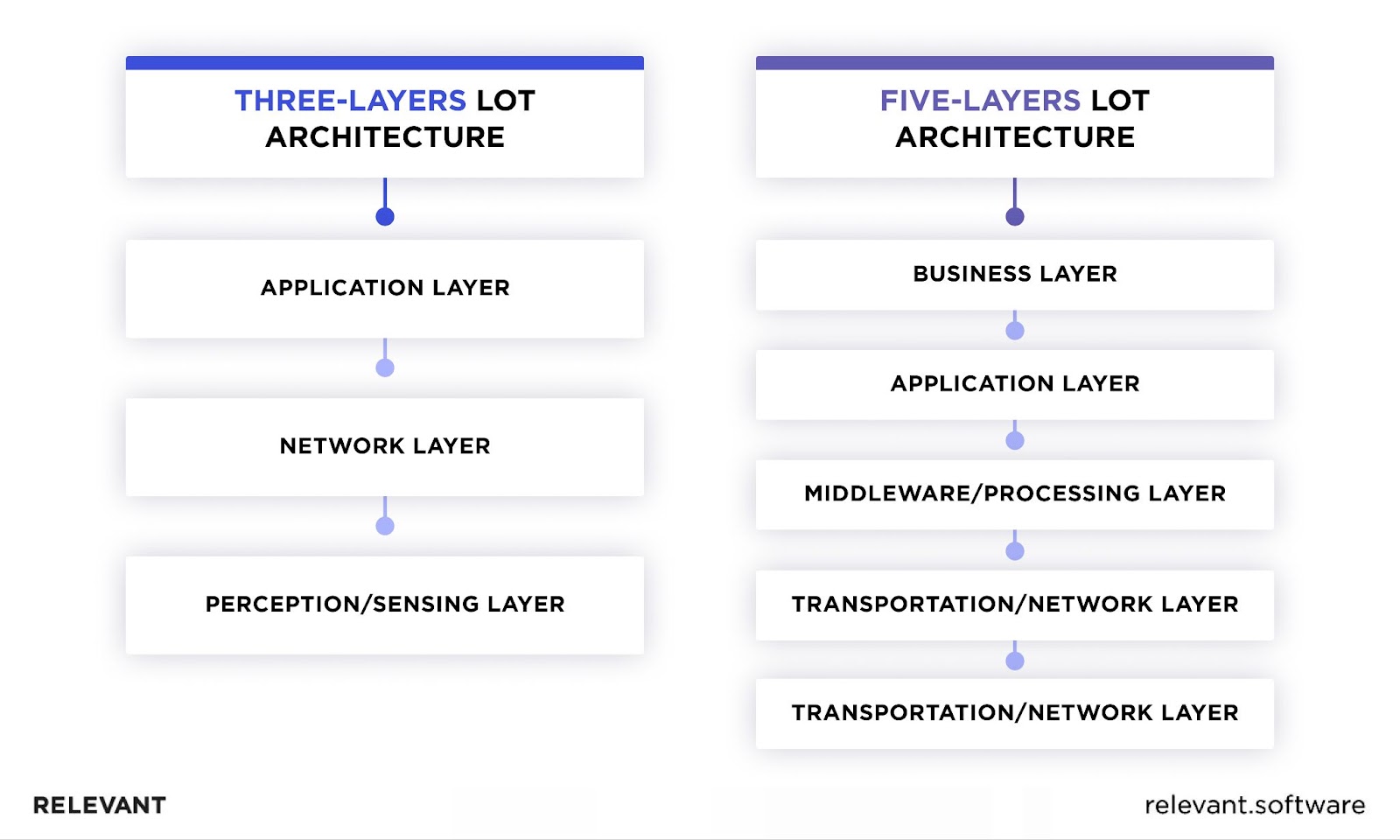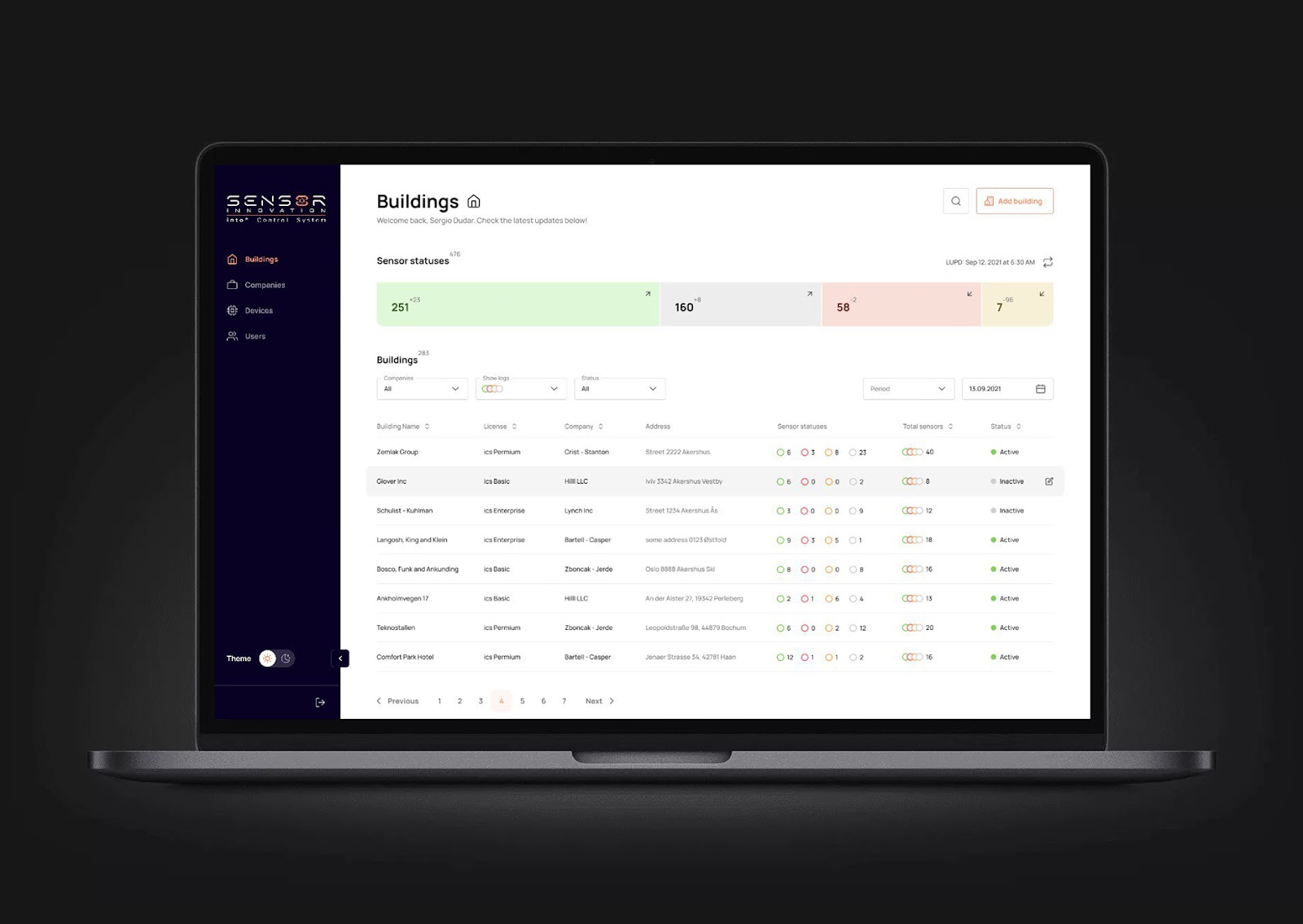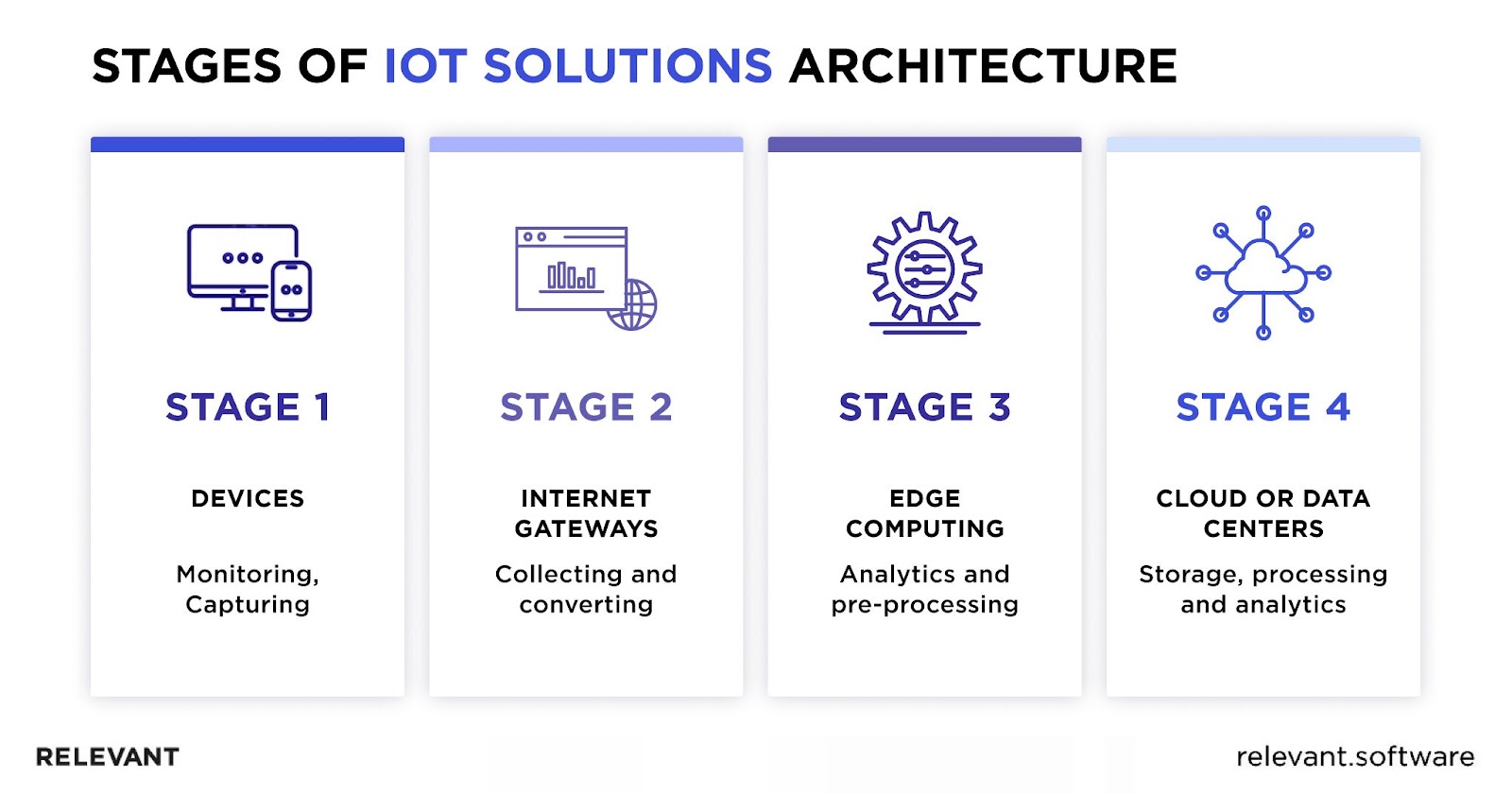The Pillar of Smart Devices: IoT Architecture Introduction

The Internet of Things (IoT) is steadily reshaping the digital landscape, transforming everyday items into sophisticated, interconnected tools that gather and share data effortlessly. This isn’t the result of a single breakthrough. It’s genuinely the result of weighty improvements in sensor technology, ways devices communicate, and more compact embedded systems. According to IoT Analytics, there will be over 29 billion IoT connections by 2027, making our immediate environment much smarter and more interactive. Central to this evolution is the IoT architecture.
It is a huge and mostly invisible infrastructure that involves multiple elements and interactions. But how does this architecture work? As we’ve been engaged in IoT development over the years, we will try to explain all the subtleties of this technology to you.
Brief Overview of IoT Architecture
In its most basic form, IoT architecture provides a systematic way of interaction between different components within the ecosystem. It is not all about hardware or physical devices; architecture combines software, data flow, protocols, and interfaces.
For example, an IoT environment may include a smart device that collects data and then transmits it through a communication protocol, a cloud infrastructure where processing is performed, and finally, IoT applications in which users interpret or act on the information.
Scalability, security, and interoperability are the prime thoughts in designing a well-functioning architecture of IoT. It has to be scalable to accommodate more devices, robust enough to ensure data security, and flexible enough for hassle-free interactions between different manufacturers’ devices.
IoT Architecture Models
Diving into the topic of IoT architecture requires an acknowledgment: there’s no one-size-fits-all design. The intricacy of a tailored IoT system for a particular enterprise depends on the specific issues these connected tools are set to solve. That said, even though the setup for each IoT initiative might differ, most are anchored around certain consistent architectural tiers.
Diving into the world of IoT architecture for beginners or even experienced developers can seem a little overwhelming at first. But, understanding the different types of IoT architecture is crucial when we’re trying to build a system that does exactly what is needed.
Three-Tier IoT Architecture Overview
When discussing IoT, a commonly referenced model is the three-tier IoT architecture. It strategically segments IoT systems into three specific layers, promoting logical task distribution and streamlining data processes. Here’s a closer look:
Perception Layer
Often referred to as the “sensing” segment, this layer represents the IoT system’s point of contact with the physical world.
- Purpose: Its main task is to capture, assimilate, and transmit raw data to the next stages.
- Components: It encompasses sensors, actuators, and various data-gathering tools. For illustration, consider a smart thermostat leveraging temperature sensors to measure room warmth.
- Operations: Tools in this category observe their surroundings, transform real-world observations into digital metrics, and transmit this information. A pertinent example could be a moisture detector in advanced agricultural tech, persistently tracking and noting the air’s humidity levels.
By providing a structured approach, the Three-Tier model aids in making IoT implementations more manageable and effective.
Network Layer
The network layer is sometimes referred to as the “transport” layer. Serving as a channel, it ensures the seamless transition of data gathered by the perception layer to its designated processing hub.
- Purpose: The core objective of this layer is data conveyance. It emphasizes the reliable, swift, and secure relay of information to its pertinent location.
- Components: This segment integrates a variety of communication techniques and protocols. The spectrum extends from close proximity communication methods, such as Bluetooth and Zigbee, to more extensive range technologies like Wi-Fi, cellular connections, or, in specific scenarios, satellite links.
- Operations: After preliminary processing like data aggregation or compression, data fragments are channeled through the best-suited routes to their designated destinations, which could be localized servers, expansive cloud infrastructures, or alternative connected tools.
Through such a structured approach, the network layer ensures the agile and secure movement of data within the IoT framework.
| IoT Networking Technologies | |
| Technology | Key Attributes |
| Wi-Fi | Commonly used for local wireless connectivity within a specified area, often within buildings. |
| Bluetooth & BLE | Facilitates short-range interactions. BLE focuses on minimal power consumption for such exchanges. |
| Zigbee | Provides an economical wireless protocol designed for brief, local device interactions. |
| LoRa | Efficient in terms of energy, this tech offers connectivity over vast distances, suitable for remote devices. |
| NB-IoT | Cellular tech catering to expansive networks, ensuring wide-area connectivity. |
| LTE-M | Another cellular solution dedicated to specific bandwidths and ideal for vast IoT setups. |
| Z-Wave | Commonly integrated into smart home technologies, aiding in automating residential devices. |
| Ethernet | Traditional wired tech ensures dependable connections, optimal for high-data processes. |
| 5G | A pioneering cellular tech that boasts rapid connectivity, ideal for hosting a multitude of IoT devices. |
Application Layer
Positioned atop the IoT hierarchy, the application layer stands as the focal point where raw data evolves into meaningful, actionable insights.
- Purpose: This tier is tasked with data interpretation, frequently employing advanced algorithms or analytical instruments and then relaying this information in an accessible manner. It also might be the source of automated directives drawn from the assessed data.
- Elements: Included within this layer are user interface designs, software applications, data storage systems, and analytical platforms. To illustrate, within a sophisticated home system, this layer would house the user panel showcasing energy usage patterns or automation criteria that power down lights when spaces are unoccupied.
- Operations: Features in this layer, tailored to the unique goals of each IoT setting, may include sending notifications to consumers, merging data with external systems, triggering automation based on data assessment, or providing visuals for a more intuitive understanding of accumulated information.
This layer, therefore, serves as the convergence point of technology and usability, ensuring that the IoT system is not just efficient but also user-centric.

Five-Tier IoT Architecture
When discussing IoT, the five-tier architecture is a more refined model than the three-tier version, designed to meet the diverse and growing challenges of today’s IoT setups. By including more layers, this model promises to be more adaptable and versatile. Let’s dive into each tier:
Perception Layer
Think of this as the eyes and ears of the IoT system architecture. It’s the first point of contact with the actual, physical world around us. It consists of a number of entities – sensors, cameras, actuators, and other devices that collect data and perform actions.
- Purpose: Primarily, its job is to detect, collect, and turn environmental data into a digital format.
- Components: Here, we find devices like sensors, RFID tags, cameras, and more. Essentially, they turn real-life occurrences into electronic data.
- Operations: This layer is all about real-time tracking of different measures like temperature, light intensity, movement, and so on. After capturing this data, it’s passed on to the next tier for further handling.
Transport Layer
The transport layer of an IoT system architecture transmits data from devices such as on-site sensors, cameras, and actuators to either on-premise or in-cloud data centers.
- Purpose: Simple. Make sure data gets from point A to point B efficiently.
- Components: It’s packed with various communication technologies and protocols, be it a close range like Zigbee, Bluetooth, or more widespread methods such as Wi-Fi or 5G.
- Operations: Think of it as the post office. After sorting (aggregating and compressing) the ‘letters’ (data), it makes sure each one gets to its destination safely and promptly.
Processing Layer
Think of this layer as the brain behind the operations, the place where data isn’t just stored but transformed into something meaningful.
- Purpose: Its primary duty is to take incoming data, give it a good polish, and store it. This isn’t about mere accumulation, it’s about making that data usable.
- Components: This is where the heavy machinery comes into play – data centers, cloud servers, and those all-important edge computing nodes that crunch numbers on the go.
- Operations: When data lands here, it’s not left untouched. It’s fine-tuned, set right, analyzed, and stored for a bit. Because much of this happens near where the data comes from, things move faster, and decisions are made more promptly.
Application Layer
The application layer in an IoT system takes all the complex data and turns it into straightforward visuals, like graphs and tables, so people can easily get the gist of it.
- Purpose: Basically, its job is to collect all the information and present it in a way that we can easily understand and trigger automatic actions when necessary.
- Components: You’ll find here user-friendly screens, easy-to-read dashboards, smart algorithms that make decisions, and systems that ping you with alerts.
- Operations: What it does depends on the type of IoT setup. In a smart home, for instance, it could show you how much electricity you’re using. In a high-tech factory, it can adjust machines automatically based on the latest data.
Business Layer
Here, we’re focusing more on how the IoT system fits into the bigger business picture. It’s all about ensuring that every byte and bit aligns with the mission and goals of the organization.
- Purpose: Think of this as the layer that makes sure the IoT system isn’t just technologically sound but also aligns with the grander business objectives and strategies.
- Components: This isn’t just about technology. Here, we’re integrating tools that aid in decision-making, evaluate returns on investments, manage policies, and other critical strategic elements.
- Operations: Guided by feedback from the Application Layer, this layer is where choices related to business pathways, gauging ROI, tweaking policies, and more take place. The essence is to confirm that the IoT setup doesn’t just work well but actively elevates the business it’s a part of.
To put it plainly, the five-tier IoT architecture is your holistic guide to creating and handling IoT systems, striking a fine balance between tech specifics and broader strategy.
For example, the Relevant team developed an all-in-one platform for our client Sensor Innovation, to manage sensors conveniently, including real-time data monitoring and alerts. In this case, IoT applications serve as a business layer that allows users and service companies to more effectively monitor the status of sensors, analyze their performance, and collect other necessary data.

Stages of IoT Architecture
The intricate design of IoT systems can be demystified by breaking it down into distinct stages, which together make up the holistic IoT network architecture. These stages, often visualized in an IoT architecture diagram, ensure that devices can collect, process, and act on data efficiently. By understanding these key components, we can gain a clearer perspective of the architecture of IoT. Let’s dive into each stage:
Devices
At the very foundation of any IoT layered architecture are the devices themselves.
- Purpose: These are the primary sources of data responsible for capturing real-world parameters and interactions.
- Components: The term ‘devices’ envelops a plethora of gadgets, from simple temperature sensors to complex industrial machines.
- Operations: Through sensors and actuators embedded in them, connected devices monitor and capture data, becoming the bedrock of the IoT layer architecture.
Internet Gateways
Gateways serve as the crucial bridge in the IoT platform architecture, ensuring that the data from devices finds its path to the broader Internet infrastructure.
- Purpose: They act as intermediaries, facilitating data transition from local networks to wide-area networks.
- Components: Consisting of routers, gateway devices, and modems, they manage and optimize data flow.
- Operations: The Data Acquisition System (DAS) process, filter, and aggregate data before it’s sent ahead. It also plays a security role, safeguarding the integrity and confidentiality of data as it traverses the IoT network architecture.
Edge Computing
While the cloud offers immense computational power, the growing demand for real-time operations has given rise to edge computing in the IoT reference architecture.
- Purpose: To process data closer to the source, thereby reducing latency and ensuring rapid, real-time decision-making.
- Components: These are often local computational units strategically placed near IoT devices, like a local server on a factory floor or computing nodes in a smart vehicle.
- Operations: Instead of sending all data to the cloud, edge nodes preprocess a significant chunk, ensuring only vital information moves further. This offloads the central IoT cloud architecture, making the entire system more efficient.
Cloud or Data Centers
Once data gets past the gateway, the IoT cloud architecture comes into play. This is where the heavy-duty computation, storage, and analytics happen.
- Purpose: To provide centralized storage, processing and analytics capabilities for the vast amount of data flowing in.
- Components: Comprising powerful servers, databases, and analytic tools, the cloud serves as the core of the IoT system architecture.
- Operations: The data here undergoes rigorous processing, analytics, and storage operations, turning raw data into meaningful patterns and insights in the context of types of IoT architecture.
In conclusion, these stages illustrate the progression of data in the architecture of IoT. Whether you’re looking at an IoT architecture layers diagram or diving deep into the specifics, understanding these stages is fundamental to grasping the vast landscape of IoT solutions.

Key Considerations in Designing IoT Architecture
Building a robust IoT architecture isn’t just about connecting devices and hoping for the best. And it isn’t just about technical know-how; it’s also about making smart choices. Here’s what we look at:
Scalability
This is all about making sure our system doesn’t freak out when it grows. Can it handle more users, more data, more everything without a hitch? As the IoT universe expands, it’s not just about a few devices but potentially millions, or even billions, coming online.
- Growth Preparedness: Can your architecture handle ten devices? What about ten thousand or a million? As more gadgets go online, the infrastructure should smoothly support that surge without faltering.
- Flexible Design: Scalability also means that the system can adapt to different scales of operation, whether it’s a smart home setup or an entire smart city.
Security and Privacy
Arguably, one of the most significant concerns with IoT is ensuring the data it handles and the devices themselves are secure.
- Data Protection: IoT devices often handle sensitive information, from personal details to location data. Keeping this data safe and sound from any sneaky intruders? That’s a top priority.
- Device Security: Beyond data, the devices themselves can be targets. Ensuring they can’t be hijacked or manipulated is crucial.
- Privacy Concerns: Alongside security, the architecture should respect user privacy, only collecting what’s necessary and ensuring transparency in its use.
Interoperability
IoT brings together a wide variety of devices, each coming from different makers and running on diverse platforms. They all need to work smoothly together.
- Standard Protocols: Adopting widely accepted communication standards ensures that different devices can talk to each other without a hitch.
- Integration Capabilities: A well-designed IoT system should be able to integrate with other systems easily, whether it’s pulling data devices from an older infrastructure or syncing with a new software platform.
Energy Efficiency
A lot of IoT gadgets are either mobile or tucked away in distant spots, so their power use really matters.
- Optimized Consumption: We need these gadgets to sip, not gulp energy. This way, they last longer out there.
- Low Power Modes: Features like “nap” modes help make sure they’re only wide awake and using juice when they really have to be.
- Sustainable Sources: It’s a good idea to power them with eco-friendly options if we can. It just adds to the “do-good” factor.
In short, building an IoT system isn’t just about today’s needs. We’re playing the long game, thinking about what might come our way down the road. Get these things right, and you’ve got a system that’s solid today and ready for tomorrow.

Emerging Trends in the Architecture of IoT
The Internet of Things (IoT) keeps adapting as tech evolves and as we discover more ways to use it. Here are some notable shifts:
AI and Machine Learning Integration
Merging the world of the IoT with the brainpower of AI and the learning abilities of ML is a pretty big deal. Think about it:
- Smart Analysis: Today’s IoT devices do more than just collect data. They understand and act on it. For instance, imagine a fridge that not only tracks your milk supply but can suggest a tasty dinner recipe based on what’s inside.
- Predictive Maintenance: For industries, machines with ML can raise a flag before they break down. This helps companies fix problems before they even start, avoiding expensive repair costs.
- Enhanced User Experiences: Devices can get to know you better. AI helps in personalizing your experience. Like a music speaker that learns your taste over time and plays songs you’re likely to enjoy.
5G and Advanced Connectivity
5G is going to change the way our IoT devices connect.
- Faster Speeds: 5G means things like video streaming or self-driving cars work faster and with less lag.
- Better Connections: Apart from speed, 5G offers stronger and more reliable connections, which is vital for critical tasks in healthcare or factories.
- Handles More Devices: As everyone gets more devices, 5G can manage them all without slowing down.
Edge and Fog Computing
With every new device we bring into our homes, there’s an added responsibility to consider its impact on the environment.
- Durable Designs: Many of today’s IoT devices are crafted to stand the test of time. This not only saves us money in the long run but also results in fewer gadgets being discarded.
- Intelligent Energy Use: It’s pretty neat how some devices can self-regulate their energy consumption. Take, for example, modern thermostats that adjust settings when they sense the house is empty.
- Mindful Production: On the manufacturing side, there’s a noticeable shift. Businesses are leveraging technology to monitor and cut down emissions during production.
Wrapping it up, as our world grows more tech-centric, it’s heartening to see a conscious effort to marry innovation with eco-friendliness. The path ahead for IoT isn’t just about smart connections but about making choices that benefit our planet too.
Internet of Things (IoT) Architecture Use Cases
While the technicalities of IoT architecture for beginners might seem daunting, real-world applications simplify its understanding.

The Rise of Smart Cities
Do you know the frustration of being stuck in traffic during rush hour or the hassle of searching for a parking spot downtown? Well, imagine a city that could ‘think’ and adjust its infrastructure based on our needs. That’s the promise of smart cities. By leveraging IoT, urban areas are becoming more responsive. Streetlights that adjust based on natural light, traffic lights that change in real-time to ease congestion, and waste bins that notify collection trucks when they’re full are just a few examples. Life in the city is getting a bit easier, thanks to IoT.
Healthcare Gets a Tech Boost
Remember those regular visits to the doctor just for routine check-ups? Now, with IoMT development services, many of those can be avoided. Wearables like heart rate monitors or glucose meters allow doctors to keep tabs on patients without them leaving their homes. Hospitals are using connected devices to keep closer tabs on in-house patients, administer the correct dosages, and even locate equipment. The result? Fewer errors, faster response times, and potentially, a quicker road to recovery.
Industry 4.0 and the Magic of IIoT
Talk to anyone in manufacturing, and they’ll tell you about the challenges: machines breaking down, inefficiencies in the production line, and the constant drive to reduce costs. Enter IIoT. By connecting machinery and systems, factories are turning into well-oiled machines (pun intended). Downtimes are reduced, processes are streamlined, and suddenly, that huge order that looked challenging is completed ahead of schedule.
Conclusion
We’ve highlighted some of the leading approaches to IoT architecture. Though no hard-and-fast rules exist, the key is to align your chosen architecture with your product’s unique requirements. Building the IoT reference architecture for your offering demands a skilled tech crew that thrives on resolving complex problems.
At Relevant, we boast a dedicated team of specialists who can develop top-tier IoT or IoMT solutions for you. Drawing from our vast reservoir of skilled professionals worldwide, we pride ourselves on delivering results that meet the expectations of nearly all our clients.
Tackle your IoT architectural needs with confidence by getting in touch. We’ll respond promptly to assist you further.



